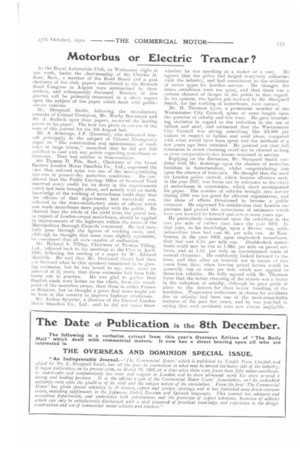Motorbus or Electric Tramcar ?
Page 7

If you've noticed an error in this article please click here to report it so we can fix it.
At the Royal Automobile Club, on Wednesday night of Iasi. week, under the ehnirmanship of Sir Charles D. !lose, Bart., a member of the Road Board and a past chairman of the club, papers contributed to the Brussels Road Congress in August were summarized by their authors, and subsequently discussed. Readers of this journal will be primarily interested in a shout report upon the subject of the paper which dealt with publicservice vehicles.
Mr. Shrapnell Smith, following the introductory remarks of Colonel Crompton, Mr. Worby Beaumont and Mr. A. Mallock upon their papers; reviewed the leading poiuts in his paper. The text was given in ext ch so in the Issue of this journal for the 4th August last.
Mr. A. Armitage, J.P. (Taunton), who addresssd himself principally to the subject of Colonel Cromptun's paper on "The construction and maintenance of roadways in large towns," remarked that he did not feel qualified to oeal with any points regarding motorbuses or tramcars. They had neither in Somersetshire.
Sir Thomas D. Pile, Bart., Chairman of We Great Eastern London Motor Omnibus Co., Ltd., expressed the view that reduced noise was one of tile most-gratifying
features in present-day motorbus conditions. He considered that the Public Carriage Office of Scotland Yard deserved every credit for its share in the improvement Which had been brought about, and nobody with an inside knowledge of the working of motorbuses could deny that We officers of that department had materially contributed to the more-satisfactory state of affairs which now made motorbuses more popular with the public. He claimed that the whole of the yield from the petrol tax, in respect of London-owned motorbuses, should be applied to improvements of the highways within the areas of the Metropolitan Borough Councils concerned. He had carefully gone through the figures of working costs, and, although he thought that some were slightly optimistic, he considered that all were capable of realization.
Mr. Richard S. Tilling, Chairman of Thomas Tilling, Ltd., referred back to the meetings al the Club in April, 1906, following the reading of a paper by Mr. Edward Manville. He said that Mr. Shrapnell Smith had then put forward what he (the speaker) considered to be glowing estimates, but he was bound to say, now. after an interval of years, that those estimates had been fully
borne out in practice. He was glad to gather tha.t.
English roads were better on the whole, from the standpoint of the motorbus owner, than those in either l''rftnre or Belgium, but he thought a great deal more might yet be done in this country to improve highway conditions. Mr. Arthur Spurrier, a director of the Central London Motor Omnibus Co., Ltd., said he did not quite know whether he was speaking as a maker or a user. Ile agreed that the police had helped everybody colTnecteu. with the industry, and had contributed to the eVidution. of better types for London service, lie thought the latest omnibuses were too quiet, and that there was a. certain element of danger to the public in that regard. In his opinion, the figures put forward by Mr. Shrapnell Smith, for the working of motorbuses, were correct.
Mr. H. Thomson Lyon, a prominent member of the Westminster City Council, spoke at some length upon the question of sideslip and tire wear. Be gave interesting statistics in regard to the reduction in the use of ballast and sand, and estimated that the Westminster City Council was saving something like .t3,000 p-er annum in respect of ballast and sand alone, compared. with what would have been spent had the methods of a few years ago been retained. He pointed out that full economies in street cleansing could not be effected SO long. as even comparatively-few horses remained in service.
Replying on the discussion, Mr. Shrapnel' Smith condoled with Mr. Armitage open the absence of motorbus. facilities in Somersetshire, whilst congratulating hint. upon the absence of tramcars. He thought that the need for London police control, which became effective early in the year 1907, was borne out by reference to the chart of motorbuses in commission, which chart accompanied his paper. The number of vehicles brought into service during 1906 was too great for efficient organization, and the state of affairs threatened to become a public nuisance. He expressed his satisfaction that Loudon experience had proved tile correctness of estimates which were put forward by himself and otlil rs some years ago.
He particularly commented upon the reduction in the cost per niihe of rubber tires since the year 1902. In that year, to his knots-ledge, upon a 30-cwt. van, solidindiarubber tires had cost 8d. per mile run. At Eastbourne, in the year 1903, upon single-deck motorbuses.
they had cost 4.hl. per mile run. Double-deck motorbuses could now be run at 1.33d. per mile on paved surfaces, and at 1.6d. per mile on macadamized roads of normal character, tie confidently looked forward to the time, and that after an interval not in excess of two years from date, when five-ton petrol lorries would be generally run at costs per mile which now applied to. three-ton vehicles. He fully agreed with Mr. Thomson Lyon that the better cleansing of the streets was a factor in the reduction of sideslip, although lie gave pride of place to the drivers for their better handling of the machines. Progressive reductions in claims for accidents due to sideslip had been one of the most-remarkabler features of the past few years, and he was justAed in saying that such accidents were. now almost negligible.




















